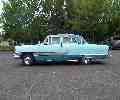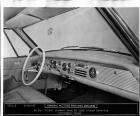|
Re: 51 Patrician - Advice on next step
|
||||
|---|---|---|---|---|
|
Forum Ambassador
|
Loosening head nuts need not be sequential.
Posted on: 2013/8/31 23:39
|
|||
|
Mal
/o[]o\ ====  Bowral, Southern Highlands of NSW, Australia "Out of chaos comes order" - Nietzsche. 1938 Eight Touring Sedan - SOLD 1941 One-Twenty Club Coupe - SOLD 1948 Super Eight Limo, chassis RHD - SOLD 1950 Eight Touring Sedan - SOLD What's this?  Put your Packard in the Packard Vehicle Registry! Here's how! Any questions - PM or email me at ozstatman@gmail.com |
||||
|
||||
|
Re: 51 Patrician - Advice on next step
|
||||
|---|---|---|---|---|
|
Home away from home

|
Probably a good idea to loosen each stud nut just slightly first up, maybe 1-2 flats initially? Can't do any harm taking this approach as all sorts of tension may have built up over the years
When it is time to 'loosen' the head you'll find a lot written about that. It can take quite a bit of time and persuasion with a plastic hammer / hammer plus wood block to break the 'seal'.
Posted on: 2013/8/31 23:40
|
|||
|
1951 Packard Club Sedan | [url=ht
|
||||
|
||||
|
Re: 51 Patrician - Advice on next step
|
||||
|---|---|---|---|---|
|
Just can't stay away
|
More progress, finally
Got the head removed. Found about an 1/8" of carbon build-up on each piston. They all looked the same. Also observed all valves moving up and down as they should - nothing stuck! Yay!! Now the question is....is the lack of compression in 7 cylinders due to rust build up and carbon build up on the valves/seats? Last tags were 1993...... My facilities are basic (outside driveway with tarp). Of course, the Oregon weather makes working on it a hit-or-miss situation. Should I put the head back on and wait til summer hits with the good weather and better economic situation? Can I just reuse the old head gasket to seal the engine up with? Is there something I can do with the valves that doesn't require a machine shop? I've played with plenty of "V" engines. Taking the heads in for a valve job is easy. This engine....not so much. And what should I expect to pay for a valve job? (assuming nothing needs replaced - supposedly a 68,000 mile car that was stored outside) So many questions....so little time and money, lol!
Posted on: 2013/9/30 19:16
|
|||
|
||||
|
Re: 51 Patrician - Advice on next step
|
||||
|---|---|---|---|---|
|
Home away from home

|
Regarding compression - did you find any scoring of the bores? If none then it's doubtful that you have broken rings. They could just be worn.
A very worn engine will typically have a step at the top of each cylinder where top ring finishes its travel, and bores may be shiny.A reasonable check for worn rings is to add a few aquirts of heavy oil down plug holes, then crank and see if the compression rises considerably compared to original readings done without oil. If it does then suspect worn rings. When the valves are open you could check if the seats and valve faces are pitted or burned, causing compression blow-past. You could fit the old head gasket just temporarily to re-test compression but a new one is necessary eventually. Also - ensure each valve closes fully when it should. If any stay open (mis-adjusted lifters, etc) this affects compression readings also. Best of luck with the project.
Posted on: 2013/10/15 4:43
|
|||
|
1951 Packard Club Sedan | [url=ht
|
||||
|
||||
|
Re: 51 Patrician - Advice on next step
|
||||
|---|---|---|---|---|
|
Forum Ambassador
|
Quote:
Got the head removed. Found about an 1/8" of carbon build-up on each piston. They all looked the same. Also observed all valves moving up and down as they should - nothing stuck! Yay!! Now the question is....is the lack of compression in 7 cylinders due to rust build up and carbon build up on the valves/seats? Last tags were 1993...... Quote: My facilities are basic (outside driveway with tarp). Of course, the Oregon weather makes working on it a hit-or-miss situation. Should I put the head back on and wait til summer hits with the good weather and better economic situation? Can I just reuse the old head gasket to seal the engine up with? Quote: Is there something I can do with the valves that doesn't require a machine shop? Quote: I've played with plenty of "V" engines. Taking the heads in for a valve job is easy. This engine....not so much. And what should I expect to pay for a valve job? (assuming nothing needs replaced - supposedly a 68,000 mile car that was stored outside) One trick I learned is to coat the valve stems with a special lubricant that Briggs and Stratton developed for their flat head engine valve stems, you can purchase it at any good lawn equipment dealer. It helps prevent stuck valves, especially in flat head engines that are not run on a daily/weekly basis. Our lawn equipment gets packed away for 6 months at a time here, then fired up in the spring.
Posted on: 2013/10/15 8:14
|
|||
|
||||









